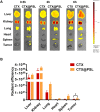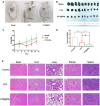Design and Application of pH-Responsive Liposomes for Site-Specific Delivery of Cytotoxin from Cobra Venom
- PMID: 38859950
- PMCID: PMC11164093
- DOI: 10.2147/IJN.S461728
Design and Application of pH-Responsive Liposomes for Site-Specific Delivery of Cytotoxin from Cobra Venom
Abstract
Background: Current immunotherapies with unexpected severe side effects and treatment resistance have not resulted in the desired outcomes for patients with melanoma, and there is a need to discover more effective medications. Cytotoxin (CTX) from Cobra Venom has been established to have favorable cytolytic activity and antitumor efficacy and is regarded as a promising novel anticancer agent. However, amphiphilic CTX with excellent anionic phosphatidylserine lipid-binding ability may also damage normal cells.
Methods: We developed pH-responsive liposomes with a high CTX load (CTX@PSL) for targeted acidic-stimuli release of drugs in the tumor microenvironment. The morphology, size, zeta potential, drug-release kinetics, and preservation stability were characterized. Cell uptake, apoptosis-promoting effects, and cytotoxicity were assessed using MTT assay and flow cytometry. Finally, the tissue distribution and antitumor effects of CTX@PSL were systematically assessed using an in vivo imaging system.
Results: CTX@PSL exhibited high drug entrapment efficiency, drug loading, stability, and a rapid release profile under acidic conditions. These nanoparticles, irregularly spherical in shape and small in size, can effectively accumulate at tumor sites (six times higher than free CTX) and are rapidly internalized into cancer cells (2.5-fold higher cell uptake efficiency). CTX@PSL displayed significantly stronger cytotoxicity (IC50 0.25 μg/mL) and increased apoptosis in than the other formulations (apoptosis rate 71.78±1.70%). CTX@PSL showed considerably better tumor inhibition efficacy than free CTX or conventional liposomes (tumor inhibition rate 79.78±5.93%).
Conclusion: Our results suggest that CTX@PSL improves tumor-site accumulation and intracellular uptake for sustained and targeted CTX release. By combining the advantages of CTX and stimuli-responsive nanotechnology, the novel CTX@PSL nanoformulation is a promising therapeutic candidate for cancer treatment.
Keywords: cobra venom cytotoxin; liposomes; pH-responsive; targeted delivery; tumor microenvironment.
© 2024 Lin et al.
Conflict of interest statement
The authors declare no conflicts of interest.
Figures






Similar articles
-
Cobra venom cytotoxins; apoptotic or necrotic agents?Toxicon. 2015 Dec 15;108:134-40. doi: 10.1016/j.toxicon.2015.09.017. Epub 2015 Oct 22. Toxicon. 2015. PMID: 26482932
-
Dual ligand functionalized pH-sensitive liposomes for metastatic breast cancer treatment: in vitro and in vivo assessment.J Mater Chem B. 2025 Feb 19;13(8):2682-2694. doi: 10.1039/d4tb02570a. J Mater Chem B. 2025. PMID: 39841132
-
Exploring the anticancer potential of Cytotoxin 10 from Naja kaouthia venom: Mechanistic insights from breast and lung cancer cell lines.Chem Biol Interact. 2024 Nov 1;403:111254. doi: 10.1016/j.cbi.2024.111254. Epub 2024 Sep 24. Chem Biol Interact. 2024. PMID: 39321861
-
Stimuli-responsive liposomal nanoformulations in cancer therapy: Pre-clinical & clinical approaches.J Control Release. 2022 Nov;351:50-80. doi: 10.1016/j.jconrel.2022.08.001. Epub 2022 Sep 20. J Control Release. 2022. PMID: 35934254 Review.
-
Recent Advancements of Stimuli-Responsive Targeted Liposomal Formulations for Cancer Drug Delivery.Pharm Nanotechnol. 2022;10(1):3-23. doi: 10.2174/2211738510666220214102626. Pharm Nanotechnol. 2022. PMID: 35156590 Review.
Cited by
-
Effect of pH on antitumor activity of Chinese cobra (Naja atra) cytotoxin-XII.Cytotechnology. 2025 Feb;77(1):21. doi: 10.1007/s10616-024-00681-8. Epub 2024 Dec 13. Cytotechnology. 2025. PMID: 39676765
-
Mitochondria-Targeting Virus-Like Gold Nanoparticles Enhance Chemophototherapeutic Efficacy Against Pancreatic Cancer in a Xenograft Mouse Model.Int J Nanomedicine. 2024 Dec 28;19:14059-14074. doi: 10.2147/IJN.S497346. eCollection 2024. Int J Nanomedicine. 2024. PMID: 39748900 Free PMC article.
References
MeSH terms
Substances
LinkOut - more resources
Full Text Sources

